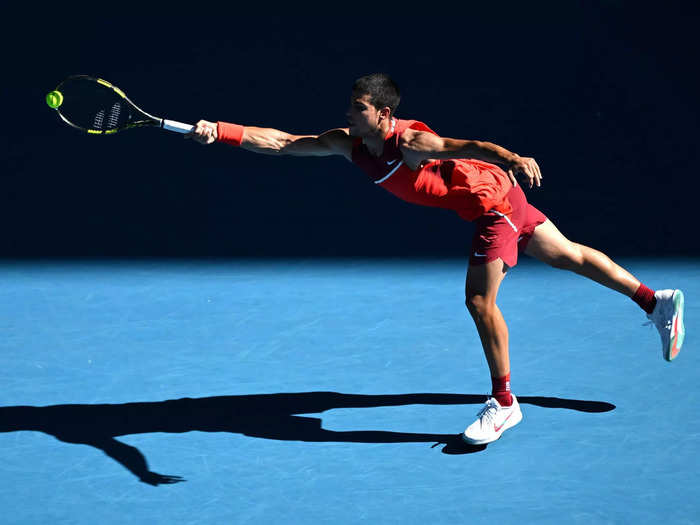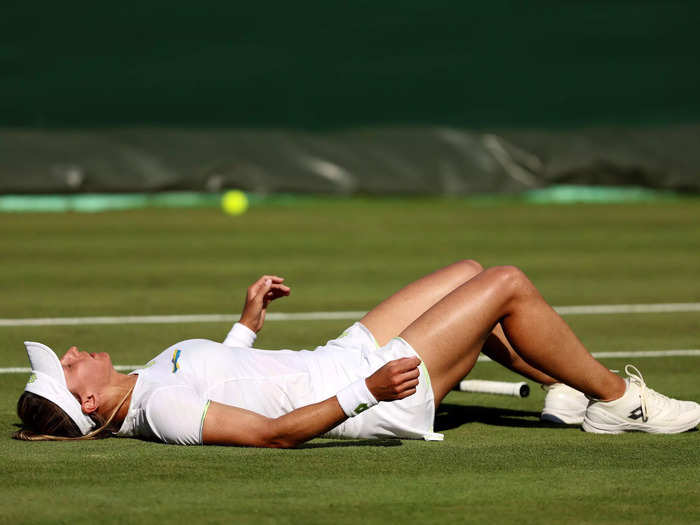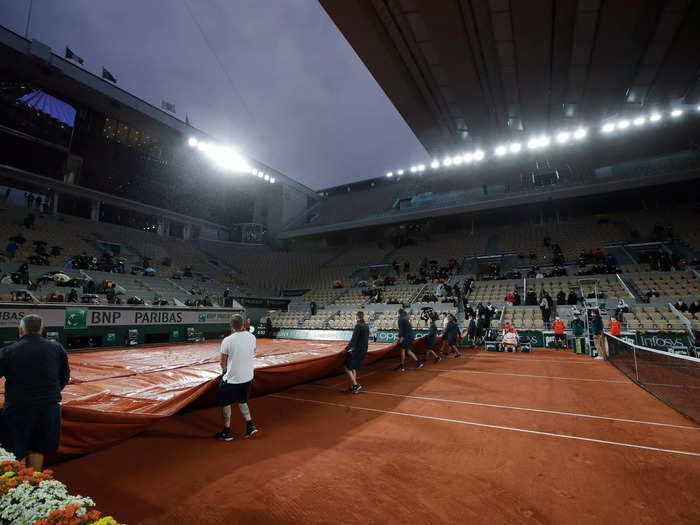Novak Djokovic hits a shot during his Round of 16 matchup at Wimbledon 2023.Charlotte Wilson/Offside/Offside via Getty Images
- Wimbledon — the most prestigious tennis event of the year — is underway.
- Fans tuning in for the third Grand Slam of 2023 may not be familiar with the game's commentary.
The most prestigious tournament on the annual tennis calendar is underway, and if you're a tennis novice hoping to follow along, you're in the right place.
The 2023 Wimbledon Championships are heating up. Superstars like Novak Djokovic, Iga Swiatek, Carlos Alcaraz, and Aryna Sabalenka are looking to add more Grand Slams to their trophy cabinets, while top talents including Ons Jabeur, Jannik Sinner, Jessica Pegula, and Holger Rune hope to break through for their first-ever major championship victories.
But for fans tuning in back home, match commentary may offer more confusion than clarity on all the action unfolding in London.
Insider's here to help. Check out this list of terms you need to know to help you follow along with tennis' top tournament:
Game
Russia's Daniil Medvedev plays at the 2019 US Open in New York's Arthur Ashe Stadium. AP Photo/Eduardo Munoz Alvarez
Each point played during a tennis match contributes to a larger game. Each player begins at 0 (pronounced "love"), then progresses to 15, 30, and 40 with each point won. The first player to surpass 40 wins the game, with the exception of games with a score line of 40-40.
Deuce
Spain's Carlos Alcaraz extends to hit a forehand shot at the 2022 Australian Open. REUTERS/Morgan Sette
Since players must win a game by at least two points, the game moves to "deuce" when the score reaches 40-40. The player who wins the next point has the "advantage," but if their opponent wins the subsequent point, the game returns to "deuce."
The game concludes when a single player wins two successive points after "deuce."
Set
American Coco Gauff at the 2022 French Open. AP Photo/Jean-Francois Badias
Each game contributes to the score of a "set." If one player wins six games before their opponent wins four, that first player wins the set. But if neither player has a multi-game advantage before each has secured six games, then the set is decided by a tiebreak.
Tiebreak game
Ukraine's Lesia Tsurenko celebrates winning the longest tiebreak game in women's singles Grand Slam history at 2023 Wimbledon. Clive Brunskill/Getty Images
When the score of a set is tied at 6-6 (pronounced "six all"), the set is decided by a "tiebreak" game. As with regular games, players must win by at least two points, but tiebreak games are scored 0, 1, 2, 3, etc.
The first player to 7 (or 10, in the case that a tiebreak game decides the final set) wins the tiebreak game, and the set. But if the lead is less than two games by the time one player reaches 7 (or 10 for the final set), the tiebreak game proceeds until one player secures a two-point advantage. Once one player prevails, they claim the set by a score of 7-6.
Competitive tiebreak games can end with high scores (17-15, for example). On several occasions on both the men's and women's sides, Grand Slam singles matches have featured tiebreak game scores of 20-18.
Match
Ukrainian Elina Svitolina celebrates winning her Round of 16 match at Wimbledon in 2023. Susan Mullane-USA TODAY Sports
In women's singles, players need to win two sets to secure the match. In men's singles at Grand Slams, players must win three sets to prevail in the match. Women's matches, therefore, can go for a maximum of three sets, while men's matches can extend to five sets.
Walkover
Kazakhstan's Elena Rybakina embraces Brazil’s Beatriz Haddad Maia after she retired with an injury in their fourth-round match at Wimbledon. REUTERS/Hannah Mckay
If a player pulls out — or "retires" — from a match for any reason, most commonly due to injury or illness, their opponent receives a "walkover" into the next round of the tournament.
Suspended
Stadium workers pull a tarp over a court at the 2020 French Open after matches were suspended due to inclement weather. AP Photo/Alessandra Tarantino
Matches can be "suspended," or delayed, due to a number of external factors. Weather and insufficient light are the most common reasons matches are suspended at Grand Slam tournaments.
At Wimbledon, where there is an 11 p.m. curfew, nighttime matches are sometimes suspended until the following day.
Ace
American John Isner holds the record for most aces in men's tennis. Danielle Parhizkaran-USA TODAY Sports
A player earns an ace when they successfully serve the ball in play and their opponent fails to touch it with their racket. An ace is a player's quickest path to a point.
Fault
Spain's Rafael Nadal serves the ball at the 2023 Australian Open. AP Photo/Aaron Favila
When the server fails to play the ball into proper service box, they receive a "fault." If a player fails to serve the ball into the proper service box twice in a row, they receive a "double fault" and lose the point.
Let
Poland's Iga Swiatek serves the ball at the 2022 US Open. Danielle Parhizkaran-USA TODAY Sports
A "let" takes place when an attempted serve grazes the top of the net but still lands in the correct service box — the small area of the court where a serve must bounce. The server is allowed to replay the point when a let occurs on the first serve. A let on the second serve results in a repeated second serve.
Hold
Greece's Stefanos Tsitsipas celebrates a point. SEBASTIEN BOZON/AFP via Getty Images
A player "holds" when they win their service game — aka a game in which they served. When players have won their respective service games within a set, they are "on serve."
Break
Aryna Sabalenka celebrates a play during the 2023 Australian Open final. REUTERS/Carl Recine
A player is expected to win — or hold — their service games. When the receiving player wins the game instead, they go up a "break." If one player does so twice, they go up a "double break."
Grand Slam
Novak Djokovic poses with his trophy from the 2023 Australian Open. REUTERS/Jaimi Joy
A "Grand Slam" is any of the four major tournaments on the tennis calendar. These include, in order, the Australian Open, the French Open (or Roland-Garros), Wimbledon, and the US Open.
Winning all four of these tournaments in a single year is also referred to as a "Grand Slam."













